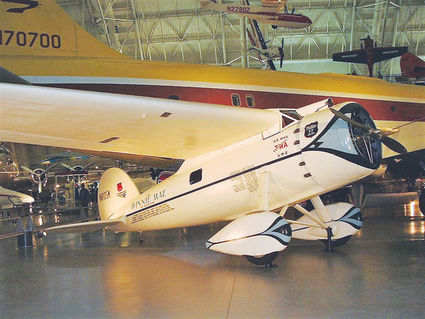Wiley Post and his airplane Winnie Mae
Short Flights
My father, M. G. Hellwig, worked for TAT Airlines (Transcontinental Air Transport), predecessor to TWA (Trans World Airlines). TAT was an airline founded in 1928 by Clement Melville Keys. In 1930, TAT merged with Western Air Express to become TWA. My father often spoke of Wiley Post and the Lockheed Model 5C Vega called Winnie Mae that the famed aviator flew.
A Vega painted like Winnie Mae used to be in the Tall-Manz Aviation Museum at Orange County Airport and I remember seeing slides that my father took of my brother, Cliff Hellwig, standing next to it. The event was a reunion of people who worked for TWA and he was invited.
I still have all of the slides and hope one day to convert them to CD's so I can see them on the computer.
This photo was taken when my husband, Al and I visited the Udvar Hazy Museum at Dullas Airport in Washington D.C. in 2004.
Famous pilot Wiley Post flew Winnie Mae. He was well-known on the barn-storming circuit in the 1920s and was in an oil field accident in Oklahoma in 1926 that caused him to lose his left eye. Apparently, the eye became infected and was spreading to both eyes. Fearful of going totally blind, Post agreed to have the doctors remove his left eye.
Depth perception was a problem, but he trained himself to gauge distances through practice; he learned to land a plane by using the height of telephone poles and two-story buildings and went on to make a living teaching student pilots, flying oilmen to their rigs, and barnstorming on weekends.
Post was the personal pilot of wealthy Oklahoma oilmen Powell Briscoe and F.C. Hall and in 1930 Hall bought a high-wing, single-engine Lockheed Vega. The Vega was one of the most famous record-breaking planes of the early 1930s.
The plane was named after Hall's daughter, Winnie Mae, and Post achieved national prominence when he won the National Air Race Derby, from Los Angeles to Chicago in 9 hours, 9 minutes and 4 seconds on Aug. 27, 1930.
June 23, 1931, Post flew Winnie Mae, accompanied by Harold Getty as navigator, around the world. They took off from New York to make a world circuit in record time. The first stop was Harbor Grace, Newfoundland. From there, the fourteen-stop course included England, Germany, Russia, Siberia, Alaska, Canada, entered the U.S. again in Cleveland, and finally to New York on July 1, 1931. The flight took 8 days, 15 hours, and 51 minutes.
After that round-the-world flight, Hall presented the Winnie Mae to Post as a gift. His second circumnavigation of the world started on July 15, 1933. Post left New York, closely following his former route but reducing his stops to only eleven, he made a 15,596-mile circuit of the earth in 7 days, 18 hours, and 49 minutes.
In 1934, Frank Phillips (Phillips Petroleum Co. – Phillips 66) sponsored Post's exploration of the limits of high-altitude, long-distance flight. Winnie Mae's cabin could not be pressurized so he worked with Russell S. Colley of the B. F. Goodrich Co. to develop what became the world's first practical pressure suit.
In the first flight using the suit on September 5, 1934, Post reached an altitude of 40,000 feet above Chicago. Eventually flying as high as 50,000 feet, Post discovered the jet stream and made the first major practical advances in pressurized flight.
Post equipped the plane with an engine supercharger and a special landing gear that he could jettison. He wore his pressure suit and cruised for long distances at high altitude in the jetstream. On March 15, 1935, Post flew from Burbank, California, to Cleveland, Ohio, a distance of 2,035 miles, in 7 hours, 19 minutes. At times, the Winnie Mae attained a ground speed of 340 mph, indicating that the airplane was indeed operating in the jetstream.
A friend from Bakersfield Council Navy League, John Kolstad, gave me a photo of his uncle's business card. Ed Sweeney was a photographer for Wiley Post.
Unfortunately, while surveying a mail-and-passenger air route from the West Coast of the U.S. to Russia in an experimental airplane on pontoons, Wiley Post and his dear friend Will Rogers were killed in an aircraft accident near Point Barrow, Alaska, on August 15, 1935.
I'll always think of my father when I see the Winnie Mae and remember his admiration for Wiley Post.
See you on our next flight!






